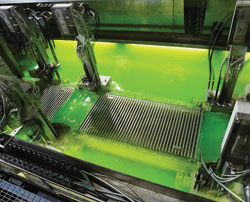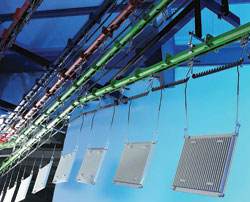The radiator industry needs to ensure it can remain competitive
and meet legislative requirements by being green, according to Mike Wright, research and development manager at Quinn Radiators
Being environmentally conscious should be seen by the radiators industry as more than just the latest trend. It should be a core value.
Consumers are more environmentally aware, and stress the need for increased efficiencies from the heating products they buy. And the government is becoming stricter in the energy performance requirements of houses. So, the radiator sector needs to embrace this move towards the greening of the industry if it is to remain competitive.
From a production point of view, there is little doubt that legislation is the biggest driver of change towards more efficient heating systems.
The government aims to achieve a 20% cut in carbon dioxide emissions by 2010 (half through energy efficiency). And, in the longer term, it wants a 60% reduction of emissions by 2050. This has led to the introduction of a number of regulations that require improvements in the energy performances of houses.
The Standard Assessment Procedure (SAP) is the government-recommended system for home energy rating. And it is based on energy costs for space and water heating only. In April 2006, a new version of the SAP energy cost rating was introduced in England and Wales – SAP 2005 – which states that the energy performance of a new dwelling will need to be about 25% better than the previous standard.
This means that houses built in the second half of this decade should emit approximately half the carbon dioxide emissions for heating, hot water and lighting than houses built a decade earlier.
Under these regulations, all new builds and conversions from April 6, 2006, must have SAP Energy Reports which need to be:
• Completed and sent in with all Building Regulation submissions
• Revisited at the end of the development to provide Building Control with an official Energy Certificate

Quinns Newport plant is designed for energy efficiency
In addition, more work in existing dwellings will now be subject to the building regulations, the intention being that, by capturing this additional work, it will become possible to incorporate energy-efficient improvements when work is planned.
SAP 2005 will be the basis for the implementation of the EU Energy Performance in Buildings Directive. This directive, which came into effect in January last year, requires calculations of energy performance to be made known to “prospective purchasers and tenants whenever buildings are constructed, sold or rented out”.
With the introduction of the Home Energy Report, the consumer must now provide efficiency and energy performance gradings (along an A, B, C scale) for all heating appliances in their home.
The establishment of the Home Energy Report, as well as the rising environmental awareness of consumers, and increasing heating costs, has led home owners and potential purchasers to look for greener appliances with the best energy ratings.
This legislation has already had an impact on the radiator industry with the move from the traditional combi boiler to condensing boilers. In addition, there has been a lowering of the average water temperature from the traditional 80˚C to 70˚C. And this is forecasted to be reduced in the future to a possible 50˚C.

The Quinn Compact claims to be the greenest radiator in the UK
Boilers would run more efficiently on lower ambient temperatures, but for longer periods of time at the comfort temperature, as opposed to a peak and low temperature as viewed by traditional radiators. As a result of this reduction of water temperature, radiator heat output is reduced by about 20% for every 10˚ drop in temperature. But more needs to be done by radiator manufacturers to remain competitive within the industry by advancing more green products and processes.
This can be done in a number of ways:
• Maximise wet surface area to increase heat radiation at a lower water temperature ie either a flat or 25mm pitch
• Maximise wet surface area to increase fin contact and quantity to increase heat convection ie either a flat or 25mm pitch
• Minimise the water content to reduce the start and stop heat up time to a minimum. Typically, standard radiators operate at 6-7l/m, whereas lower pitch radiators operate at 3-4l/m
• Grilles and side-panels should be engineered to give a maximum open surface area, as not to degrade convection output when they are compacted
• All radiators should be fitted with either oil-filled or gas-filled TRVs to minimise the energy required to heat the room
• Combi boilers should be fitted with inline filters and water softeners (where required) to maximise the performance of their heat exchangers
Quinn Radiators is playing its part in the greening of the sector by making current models more energy efficient and developing technologies that reduce the cost of home heating. At its new Newport plant, which has been designed to be energy efficient and have low emissions, Quinn is producing radiators that demonstrate the future for the industry.
For example, with its slim profile and styling based on a 25mm pitch, the Quinn Compact radiator sets standards as the greenest radiator in the UK.